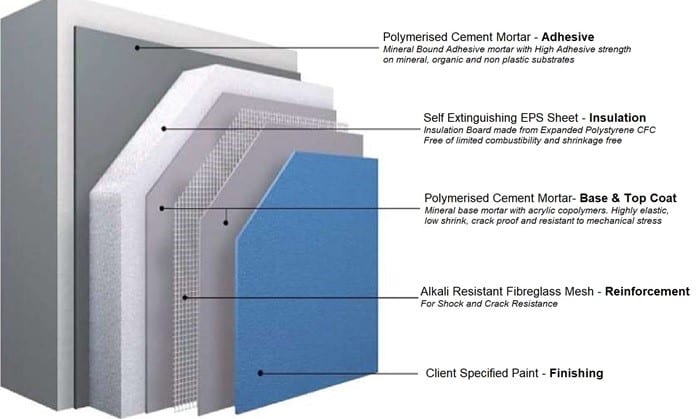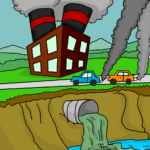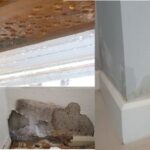STRENGTH OF SHOCK ABSORBING INSULATION LAYER
For a layperson who has not personally experienced wall insulation systems like EIFS (Exterior Insulation & Finishing System) or ICF (Insulated Concrete Formwork), the thought would be one of an impossibility.
“How can a soft exterior insulation layer survive abrasive human traffic situations?”
“How can such a layer survive the high impact mishandling by children or abusive folks?”
I remember my youthful days when the “Maruti 800” car got launched in 1983. There was so much brouhaha about the “Matchbox” car that Maruti 800 was and how it could survive a road accident. The comparison was with the “Ambassador” car, with a much thicker and stronger steel body. Maruti 800 would crumple under the impact, thus gaining the nickname of a Matchbox. However, this crumpling of designated zones would take the accident shock away from the passenger and dissipate it.
That is where design thinking deviates from a layperson’s way of thinking. The design of the Maruti 800 car was to save the passengers by absorbing the impact energy of the accident by using it to massively crumple the designed zones of the body and preventing it from reaching the passenger. As against this, the ambassador car body’s strength would prevent any such impact energy absorption and transfer the same to the softer body of the passenger instead.
UNDERSTANDING THE CONTRIBUTION OF INSULATION LAYER TO EIFS “STRENGTH”
It may be simpler to understand this aspect through multiple springs joined together in series.

If an impact force F exerts on the yellow square, it will be transferred onto the substrate through the two springs K1 & K2. Displacement, X1, X2, of the springs, will equal F/K1 & F/K2, where K is the spring stiffness. If K is high, the X will be small. Hence a strong spring with high stiffness will not compress and not absorb the impact energy. This shock energy will get transferred to the substrate causing more damage.

The external insulation systems are composite systems and may get modeled as multiple springs in series. The Insulation layer of Polystyrene foam plays the role of shock-absorbing spring. Fiber Glass Mesh in combination with polymerized cement layers is the strong, abrasion-resistant, piercing resistant layer.
These constitute a modern Composite System with multiple parts playing different roles. Hence only one component change is required to modify a specific property of the System. For external insulation systems, by using a heavier fiberglass mesh, we may design for higher impact strengths or higher abrasion resistance.
YOU CAN DESIGN FOR APPROPRIATE IMPACT STRENGTH OF EIFS
This method is exceptionally versatile and efficient. Impact resistance can vary by design using an entire range of mesh weights, and we may install the desired impact resistance just where it is needed. To be able to design this impact resistance feature, a methodology was needed to measure it systematically. The EIFS industry members association developed EIMA Test Method 10.86, standard test method for impact resistance of EIFS, Class PB (Polymer-Based), for the effect of rapid deformation or impact. This method defines the required test apparatus, specimens, procedures, interpretation of results, and reports, thus standardizing the testing. In Europe, this test, specifically for vertical building elements, was further standardized in ETAG 004 at 5.1.3.3.
IMPACT STRENGTH TESTING METHODOLOGY
One has to keep in mind a basic description of the EIMA 101.86 method. A flat EIFS specimen 2 feet square with a 1-inch insulation board is placed horizontally, coating side up, on a rigid flat surface, such as a concrete floor. A special indenter is dropped from a measured height down a vertical tube over the EIFS specimen. The indenter is a four-pound steel cylinder with a half-inch diameter hemispherical head to contact the EIFS specimen. In ETAG 004, the test specified as per ISO-7892, where a pendulum of specified weight is released to impact the EIFS specimen mounted vertically. The table above summarizes the test and result assessment methods.
COMPARISON OF AMERICAN (EIMA) AND EUROPEAN (ETAG) IMPACT TESTING SYSTEMS
| S.No. | Test Particulars | EIMA 101.86 | ISO 7892 + ETAG 004 |
| 1 | Specimen Position | Horizontal | Vertical |
| 2 | Indenter | 4 lb or 1.81 Kg | 3 Kg |
| Steel Cylinder with 1/2″ hemispherical head | For Hard Body Impact: 1 Kg Steel Ball Bearing (For 10Joules Test) and 0.5 Kg (For 3Joules Test) | ||
| 3 | Indenter shape | For Small Soft Body Impact: 3 Kg Ball of 100mm Dia with 1.5mm thick envelope of flexible rubber reinforced with canvas | |
| For Large Soft Body Impact: 50 Kg spheroconical bag made of eight sections of tarpaulin sewn together. Bag is filled with hard glass marbles of 3mm dia | |||
| 4 | Indenter movement relative to EIFS specimen | Vertical Drop from specified height in inches | Pendular drop from 450 and height of 1.02m with 1 Kg steel ball for 10 Joule test and 0.5 Kg ball from 0.61m height for 3 Joule test. |
| 5 | Test Result assessment | Maximum Drop height at vertically dropping from which the indenter will not break the mesh of EIFS Specimen in more than 4 out of 10 drops is called the passing height. This height in inches multiplied by the indenter weight in lbs gives the inch-pound/ joules (energy of impact) | Superficial damage on impact provided there is no cracking is considered as showing “No Deterioration”. The test result is assessed as being “Penetrated” if circular cracking is observed as far as the insulation for atleast 3 of the 5 impacts. |
| 6 | On the basis of these results, the specimens are categorized as: | Standard : 25-49 inch lbs (2.6-5.6 Joules) | Category I: Zone accessible at ground level vulnerable to hard body impacts |
| Medium : 50-69 inch lbs (5.7-10.1 Joules) | Category II:Zone liable to impact from thrown or kicked objects but limited impact due to height | ||
| High : 90-150 inch lbs (10.2 -17.0 joules) | Category III: Zone unlikely to be damaged by thrown or kicked objects and normal impacts | ||
| Ultra high:Over 150 inch lbs (> 17.0 Joules) | *Check table below for zone categorisation under ETAG 004 | ||
| * | Categorisation under ETAG 004 | Refer Para 5 of Test result assessment for “Penetration” & “No Deterioration” | |
| Category III | Category II | Category I | |
| Impact 10 Joules | ———-Not tested———– | Rendering not penetrated | No deterioration |
| Impact 3 Joules | Rendering not penetrated | No deterioration | No deterioration |
COMPARISONS WITH OTHER BUILDING MATERIALS
To gain a perspective on the technical aspects detailed above, please see the photographs of the effect of a similar impact on some familiar building materials. All these building materials can be presumed as fixed on a concrete horizontal face as per EIMA 101.86.

200 in lbs or 22.6 joules impact on EIFS 200in lbs or 22.6 Joules impact on 14 mm ply



CONCLUSIONS
From the above photos of test specimens, we can draw the following conclusions :
- For similar impacts, the EIFS surface gets shallower, less visible dents. The more brittle building material surfaces are dented deeper and more visibly.
- The finishing layer of texture paint helps in making the shallow dents, if at all, almost invisible.
- Impacting body bounces back without damaging the surface due to the spring action of the shock-absorbing insulation layer. The non-pierceable Fiber Glass Mesh ensures that the surface is not damaged.
- In the rare case of localized damage, we may remove insulation from that small area and replace it with a fresh piece. We can then cover this with fiberglass mesh reinforced cementitious coating.



